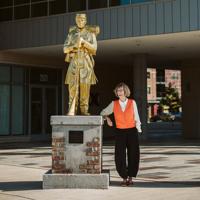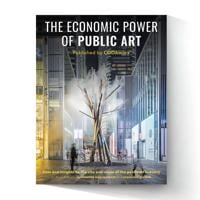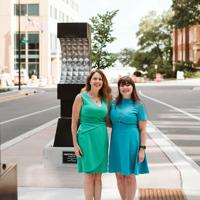After a lifetime of supporting the arts, it’s no surprise that Madison’s Toni Sikes recently made an artful move herself.
Sikes took an invisible economy — public art — and made it visible.
Artists and arts administrators have long contended with a perception that the arts are a “black hole charity that people are throwing money into,” as Wisconsin Arts Board Executive Director George Tzougros puts it.
Tzougros, who couldn’t disagree more with that perception, saw that attitude implemented to disastrous effect in 2011 when the board’s funding was slashed and Wisconsin’s Percent for Art program — which mandated that .002% of the budget for certain construction projects go toward buying and commissioning art — was repealed.
Wisconsin currently ranks 49th in per capita state funding for the arts, according to data from the National Assembly of State Arts Agencies. That’s up one slot from a year ago, when Wisconsin was dead last.
Sikes knows better than most the spuriousness of the “black hole charity” supposition. She has held numerous posts in the arts world since moving to Madison in the 1970s and is currently CEO of CODAworx, the Madison company she founded a decade ago that “connects artists to the people seeking art and the industry collaborators who make it happen,” as its website states.

Toni Sikes, pictured at Union Corners
Sikes sees the public art industry — whether it is funded publicly or privately — as a big business that generates jobs and returns on investments.
“I call it an invisible industry,” Sikes says. “The public art industry is a very large ecosystem. If you have an artist who does a $100,000 sculpture, that artist is going to hire a fabricator to make it, an engineer to come in and make sure it doesn’t fall down on somebody, a logistics company to get it from one place to another and make sure it’s installed safely, and a lighting company because they want it to show up at night.”
How to let the world know?
“The only way to get anyone to pay attention is to tell them how big it is,” Sikes says. “So we hired a market research firm. We did a major survey of the industry.”
ARTFUL FORCE: “The Economic Power of Public Art” is a new book by CODAworx and its founder, Toni Sikes.
Earlier this year, CODAworx published “The Economic Power of Public Art,” a book that offers data and analysis on the size and scope of the public art industry and how it drives community engagement. Among the highlights: In Cincinnati, the 2022 downtown BLINK festival — the largest immersive arts festival in the United States — added over 1,600 jobs and $126 million to the local economy.
A Wisconsin Arts Board study revealed that in 2022, Wisconsin’s nonprofit arts and culture industry generated more than $933 million in spending by arts organizations and their audiences. “It’s not a shrinking-violet industry,” Tzougros says.
The CODAworx book mentions the public art installation at Oregon, Wisconsin-based Gorman and Co.’s Union Corners mixed-used development on Madison’s eastside. The striking bronze sculptures include a Union soldier — the area was important during the Civil War.
“When I looked at what we were doing with the redevelopment,” company founder Gary Gorman says, “my thought was, what we’re building is probably going to be there for 100 years, and I wanted some visible evidence of why it’s called Union Corners.”
Sikes helped Gorman find a sculptor, and the company’s total investment in the artwork at the development was in excess of $200,000.
The Madison Arts Commission is celebrating its 50th anniversary this year. In September, longtime city arts administrator Karin Wolf — who now runs the public art program with Cultural Resources Planner Meri Rose Ekberg — led an arts and economic development tour from The Madison Concourse Hotel and Governor’s Club to the city’s near eastside.

CHANGE AGENTS: City arts administrator Karin Wolf and cultural resources planner Meri Rose Ekberg (left to right) are local champions for public art. Behind them is Greeting Arc II, one of two stainless steel sculptures by artist Sunghee Min that are located on the 200 block of South Pinckney Street.
“There is a little arts cluster there that is bringing in a lot of money,” Wolf says.
The tour — for participants in the American Planning Association Wisconsin Chapter’s annual conference in Madison from Sept. 12-13 — included the new home of the Wisconsin Youth Symphony Orchestra, Breese Stevens Field, the new MYArts youth center and even Giant Jones Brewing Co.
“It’s a brewery,” Wolf says, “but it also has a gallery and does many other things.”
It was a little far for the walking tour, but Wolf would have liked the group to see Dr. Evermor’s “Dreamkeepers” sculptures on Paterson Street — those giant metal birds that draw tourists and have been called the most photographed sculptures in Madison.
The city has its own percent-for-art ordinance, passed in October 2017, which requires that 1% of city funds committed to any project over $5 million go to public art. Wolf says Wisconsin “Hip Hop Architect” Michael Ford will create art on a new parking garage on South Park Street, which “will be our first completed percent-for-art project.”
She’s also excited about the public art component planned in the forthcoming Madison LakeWay/Lake Monona waterfront development.
“They’ve identified several locations and opportunities for public art,” Wolf says.
Sikes began her career in her native Alabama, helping that state increase its arts funding (it currently ranks 20th).
A June 1977 article in the Anniston Star reported that Sikes “was instrumental in the passage of the new arts budget. Working both as a coordinator of the hundreds of arts supporters across the state and as a liaison between those people and the legislature, she influenced an increased awareness in Montgomery of the state’s art constituency.”
Forty-seven years later, Sikes is hoping for the same from her adopted home state — indeed, all states. As younger generations look for places to live and visit, experiences — multidisciplinary and interactive — matter.
“People are realizing,” Sikes says, “that public art can make a difference.”
Doug Moe is a Madison writer and a former editor at Madison Magazine. Find more by Moe in his web-exclusive blog at madisonmagazine.com/dougmoe.
COPYRIGHT 2024 BY MADISON MAGAZINE. ALL RIGHTS RESERVED. THIS MATERIAL MAY NOT BE PUBLISHED, BROADCAST, REWRITTEN OR REDISTRIBUTED.
This post was originally published on this site be sure to check out more of their content











